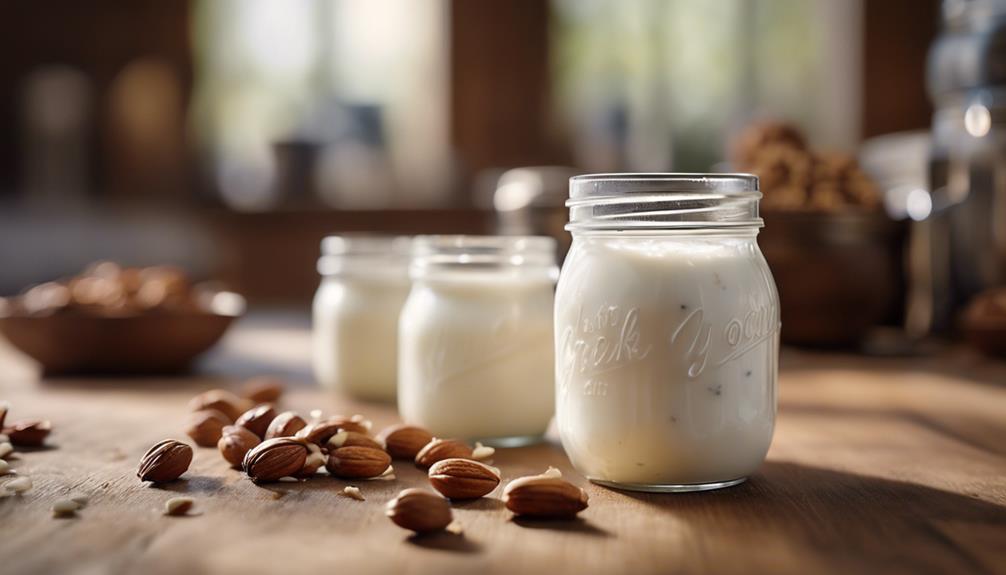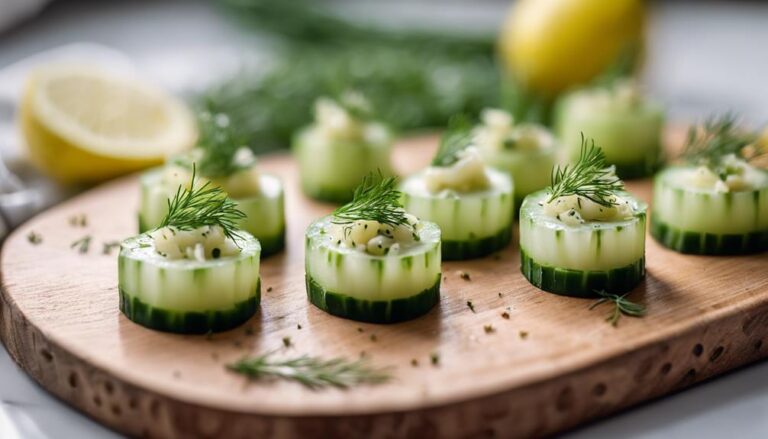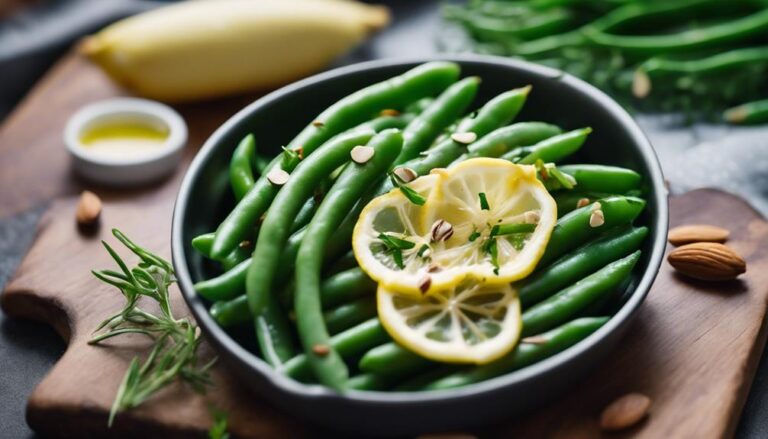Sous Vide Greek Yogurt With Vanilla and Nuts
Indulge in a gourmet treat with Sous Vide Greek Yogurt With Vanilla and Nuts. Infuse creamy yogurt with fragrant vanilla and crunchy nuts for a delightful twist on this classic snack. The precise sous vide technique guarantees consistent results and a velvety texture. Enhance your experience by savoring the sweet aroma and nutty crunch in every spoonful. Elevate your yogurt game to a new level of sophistication.
What You Will Learn Here
- Sous vide method ensures precise cooking temperatures for consistent yogurt texture.
- Greek yogurt offers a thick and creamy base for vanilla and nuts.
- Vanilla enhances flavor profile; nuts add crunch and nutritional value.
- Proper storage in airtight jars maintains freshness of yogurt.
- Experiment with different nut varieties for diverse flavor combinations.
Yogurt-Making Origins
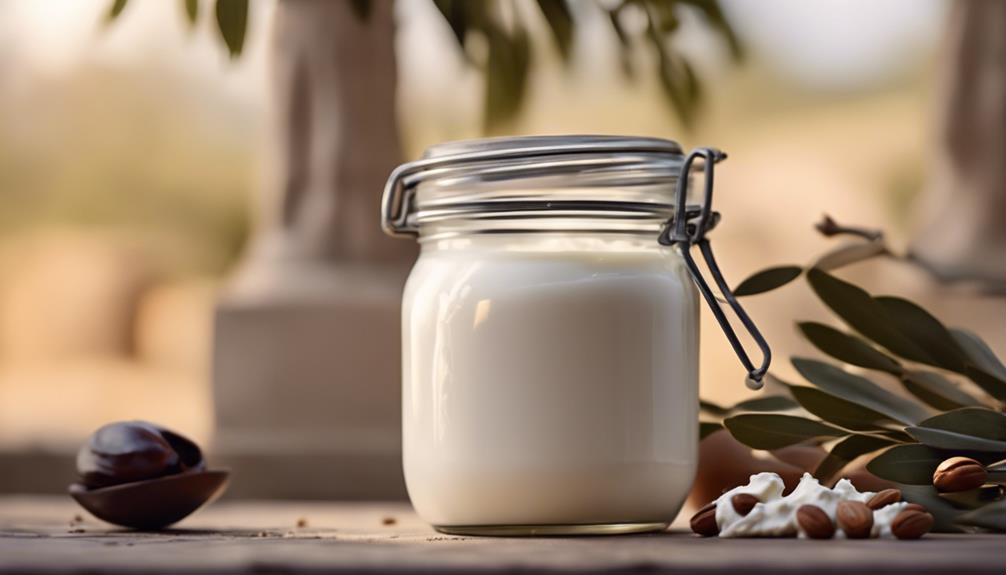
Yogurt-making has a rich history dating back to 5000 BC in Central Asia, evidenced by discoveries in ceramic pots.
The word 'yogurt,' originating from Turkish, stems from the verb 'yogurmak,' which means to thicken.
Understanding the ancient origins and evolution of yogurt sheds light on its cultural significance and widespread popularity today.
Yogurt-Making History
Dating back over 4,500 years to ancient Mesopotamia, the accidental discovery of yogurt-making marked the beginning of a culinary tradition valued for its health benefits by various civilizations.
The Greeks and Romans embraced yogurt for its probiotic properties and delicious taste. Initially made using traditional methods like fermenting milk in clay pots or animal skins in warm environments, yogurt production evolved with the introduction of commercial techniques in the late 19th century.
This revolutionized yogurt-making, leading to its widespread popularity today. From its humble beginnings in Mesopotamia to the modern sous vide yogurt recipes, the history of yogurt-making is a testament to the enduring appeal of this nutritious and flavorful dairy product.
Ancient Yogurt Origins
Ancient civilizations in Mesopotamia and the Middle East pioneered the art of fermenting milk to create a nutritious dairy product known today as yogurt. Greeks and Romans highly valued yogurt for its health benefits and long shelf life.
The process of making yogurt in ancient times involved fermenting milk in clay pots or animal skins, which allowed the milk to thicken and develop its characteristic tangy flavor. The word 'yogurt' itself is derived from Turkish, meaning 'to thicken' or 'to coagulate.'
The consumption of yogurt spread to Western cultures in the early 20th century, recognized for its health properties as a probiotic source. This ancient practice of fermenting milk has stood the test of time, evolving into the popular dairy product we enjoy today.
Evolution of Yogurt
How did the practice of fermenting milk evolve into the modern-day yogurt-making process that's familiar to us today?
Yogurt-making traces its origins back to 5000 BC in Mesopotamia, where it served as a method to preserve milk. The term 'yogurt' finds its roots in Turkish, meaning 'to thicken' or 'to curdle.'
Turkish immigrants introduced yogurt to the Western world during the early 20th century. The key bacteria responsible for yogurt fermentation are Lactobacillus bulgaricus and Streptococcus thermophilus, contributing to its unique tangy flavor and texture.
Over time, yogurt has gained global popularity due to its health benefits and versatile uses in cooking. The evolution of yogurt-making has been greatly aided by modern techniques like the sous vide machine, ensuring consistent and delicious results.
Key Yogurt-Making Components
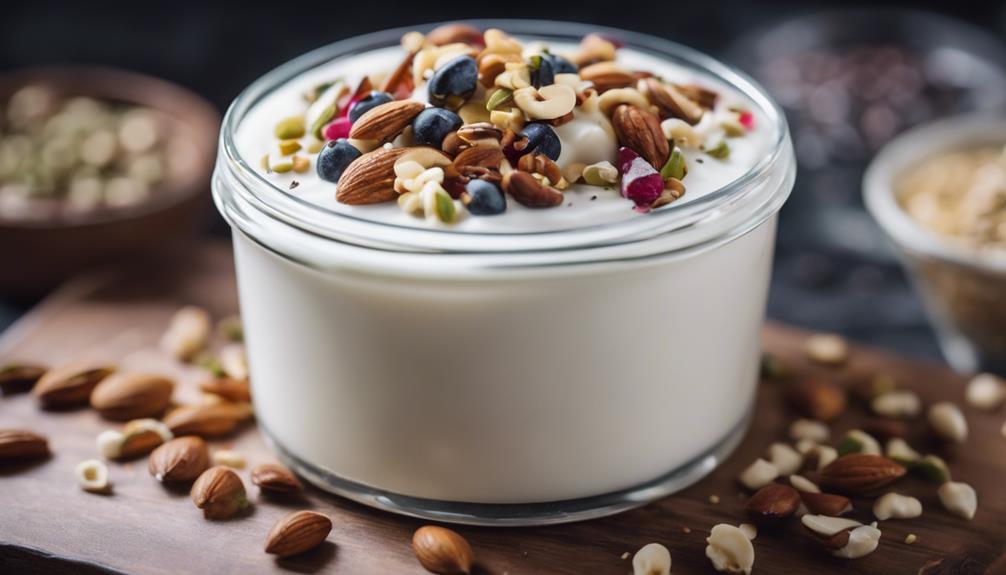
For best outcomes in making sous vide Greek yogurt, make sure the key yogurt-making components include ultra-pasteurized milk, sweetened condensed milk, Skyr yogurt as a starter, Ball Wide Mouth Pint and Half Glass Mason Jars, and an Instant Pot Accu Slim Sous Vide for precise cooking temperatures.
- Ultra-pasteurized milk simplifies the process by skipping the boiling step.
- Sweetened condensed milk enhances sweetness and creaminess.
- Skyr yogurt starter contributes to thickness and smooth texture.
Using Ball Wide Mouth Pint and Half Glass Mason Jars allows for easy storage and serving. The Instant Pot Accu Slim Sous Vide ensures precise cooking temperatures, leading to consistent results. These components are essential in creating delicious homemade Greek yogurt that's thick, creamy, and perfectly textured.
Sous Vide Yogurt Varieties
When exploring sous vide yogurt varieties, consider experimenting with different starters, milk types, and flavor additions to create a diverse range of options.
Using cold-start yogurt methods can also offer a unique twist to your sous vide yogurt creations.
Whether you prefer a classic vanilla flavor or a more adventurous fruit jam yogurt, sous vide techniques allow for endless possibilities in customizing your yogurt experience.
Cold-Start Yogurt Method
To create a velvety-smooth Greek yogurt using the cold-start method, simply combine ultra-pasteurized milk, sweetened condensed milk, and starter directly in jars without the need for preheating or boiling the milk. This simplified process offers a creamy texture and preserves the natural enzymes present in the milk for added nutritional benefits.
Cold-start yogurt can be personalized with flavors like vanilla and nuts, making it a delightful homemade treat that suits your taste preferences. Using ultra-pasteurized milk is essential for safety and successful fermentation when making cold-start yogurt.
Enjoy the convenience and delicious results of this method for crafting your own creamy and flavorful yogurt at home.
- Simplifies the yogurt-making process
- Retains natural enzymes and proteins
- Allows for customization with flavors
Sous Vide Yogurt Varieties
Exploring a range of sous vide yogurt varieties introduces an array of textures and flavors unique to each straining method utilized in crafting traditional, Greek, and Icelandic Skyr yogurt. These varieties offer diverse culinary experiences through experimentation with different straining methods.
Here are three key points to keep in mind:
- Greek yogurt: Known for its thick and creamy texture, Greek yogurt is a popular choice for its rich flavor profiles.
- Skyr yogurt: Skyr is characterized by its incredibly smooth and dense consistency, setting it apart from other varieties.
- Traditional yogurt: Traditional yogurt tends to be more liquid compared to strained varieties, offering a runnier texture that can be enjoyed in various culinary applications.
Experimenting with these sous vide yogurt options can elevate your cooking with distinct textures and flavors.
Unique Fruit Jam Yogurt Recipe
As you explore creating unique fruit jam yogurt recipes, you can infuse traditional Greek yogurt with bursts of sweetness and tanginess, elevating its flavor profile.
Experiment with homemade or store-bought fruit jams to add a burst of flavor to your yogurt.
Try combining different fruits like strawberry-basil or blueberry-lavender for exciting flavor variations.
Swirl the fruit jam into the yogurt before chilling to create visually appealing and delicious results.
Sous Vide Yogurt Storage
When storing sous vide yogurt, make sure to use airtight glass jars to maintain freshness and flavor.
Refrigerate homemade yogurt for up to 2 weeks to sustain its creamy texture.
Freezing small portions for extended preservation is ideal for future use in recipes or as a snack.
Storage Tips
For best freshness and longevity, store your homemade sous vide Greek yogurt in properly sealed glass mason jars in the refrigerator for up to 2 weeks. Keeping your yogurt in the fridge helps it set and enhances its flavors over time.
To guarantee you can track freshness easily, remember to label the jars with the preparation date. If you wish to extend the storage duration, consider freezing portioned yogurt for later use in smoothies, desserts, or as a delightful topping.
Proper Containers
Consider utilizing Ball Wide Mouth Pint and Half Glass Mason Jars as the preferred containers for storing your sous vide yogurt. These glass jars are non-reactive, preserving the yogurt's flavor and texture.
Mason jars are convenient for portioning the yogurt and can be used for serving after sous vide preparation. Opting for airtight containers like glass jars helps maintain the freshness of the yogurt.
Refrigeration Guidelines
To guarantee the longevity and quality of your homemade sous vide yogurt, proper refrigeration is key. Store your sous vide yogurt in airtight glass jars for up to 2 weeks in the refrigerator to maintain its creamy texture and preserve its flavor.
Proper chilling is essential to prevent bacterial growth and secure safe consumption. Following refrigeration guidelines is vital to maintaining freshness and enjoying your yogurt at its best.
Remember that refrigeration plays a significant role in the overall quality and safety of your sous vide yogurt. By adhering to these storage practices, you can extend the shelf life of your yogurt while keeping its taste and consistency intact.
Final Thoughts
In conclusion, the addition of vanilla and nuts enhances the sensory experience of sous vide Greek yogurt, offering a delightful blend of fragrant sweetness and crunchy texture. Vanilla brings a fragrant and sweet aroma that enhances the overall taste profile of the yogurt, providing a pleasant aromatic experience. Nuts, on the other hand, contribute to the yogurt's texture by adding a crunchy element and a nutty flavor that complements the creamy base.
Moreover, incorporating nuts into your sous vide Greek yogurt not only improves its sensory qualities but also adds nutritional value. Nuts are rich in healthy fats and protein, making your yogurt a more balanced and fulfilling snack or meal option. The combination of creamy yogurt, sweet vanilla, and crunchy nuts creates a harmonious balance of flavors and textures that cater to both your taste buds and nutritional needs. So, next time you prepare sous vide Greek yogurt, consider enhancing it with vanilla and nuts for a truly satisfying culinary experience.
Frequently Asked Questions
Can You Sous Vide Greek Yogurt?
You can definitely sous vide Greek yogurt for a creamy texture. The method offers precise temperature control. Opt for ultra-pasteurized milk and a quality starter culture. Customize with vanilla and nuts for added flavor and texture.
Can I Add Vanilla Extract to Plain Greek Yogurt?
You can add vanilla extract to plain Greek yogurt to enhance its flavor profile. The addition of vanilla creates a delicious balance of sweet and tangy notes. Experiment with different amounts to customize your yogurt to suit your taste preferences.
How Do You Dress up Vanilla Greek Yogurt?
To dress up vanilla Greek yogurt, add fruit toppings for freshness, nutty flavors for crunch, a honey drizzle for sweetness, granola crunch for texture, coconut shavings for tropical flair, chia seeds for health, cinnamon swirl for warmth, protein boost, chocolate chips, and almond butter for richness.
Can I Use Vanilla Greek Yogurt for a Yogurt Starter?
You shouldn't use vanilla Greek yogurt as a starter for homemade yogurt. Opt for plain Greek yogurt for consistent results. The cultures in vanilla yogurt can impact fermentation. Stick to plain for neutral bases in yogurt recipes.
Conclusion
To sum up, sous vide greek yogurt with vanilla and nuts offers a convenient and delicious way to enjoy homemade yogurt.
By utilizing precise temperature control and a sealed environment, sous vide technology guarantees consistent results every time.
The addition of vanilla and nuts enhances the flavor profile, creating a unique and satisfying treat.
With proper storage techniques, sous vide yogurt can be enjoyed for an extended period, making it a versatile and practical option for yogurt lovers.
